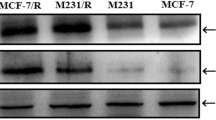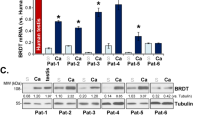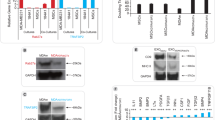Abstract
The BRCA1 (breast cancer 1) breast cancer susceptibility gene is recognized as responsible for most familial breast and ovarian cancers and is suggested to be a tissue-specific tumor suppressor gene. In this report, we investigated the tissue specificity of tumor inhibitory activities induced by a recombinant adenovirus coding for wild-type BRCA1 (wtAdBRCA1). We demonstrated a pronounced in vitro antiproliferative effect on H1299 lung and HT29 colon cells upon infection with AdBRCA1. We describe a prolonged G1 cell cycle arrest associated with a decrease in the hyperphosphorylated form of Rb, suggesting that the Rb/E2F pathway is implicated in BRCA1-induced cell growth arrest. We also observed a significant antitumor effect in these pre-established subcutaneous tumors after in situ delivery of AdBRCA1, although these two tumors do not express wt p53, and also estrogen α and β, progesterone and androgen receptors. Moreover, BRCA1 can induce a strong prolonged cell cycle arrest and apoptotic cell death but no significant antiangiogenic effect in H1299 tumors. Finally, our data indicate that intratumor administration of wtAdBRCA1 significantly inhibits growth of lung and colon steroid hormone-independent tumors.
This is a preview of subscription content, access via your institution
Access options
Subscribe to this journal
Receive 12 print issues and online access
$259.00 per year
only $21.58 per issue
Buy this article
- Purchase on Springer Link
- Instant access to full article PDF
Prices may be subject to local taxes which are calculated during checkout






Similar content being viewed by others
Abbreviations
- Ad:
-
adenovirus
- ERα or β:
-
estrogen receptor α or β
- AR:
-
androgen receptor
- MOI:
-
multiplicity of infection.
References
Miki Y, Swensen J, Shattuck-Eidens D, Futreal PA, Harshman K, Tavtigian S et al. A strong candidate for the breast and ovarian cancer susceptibility gene BRCA1. Science 1994; 266 (5182): 66–71.
Wooster R, Neuhausen SL, Mangion J, Quirk Y, Ford D, Collins N et al. Localization of a breast cancer susceptibility gene, BRCA2, to chromosome 13q12–13. Science 1994; 265 (5181): 2088–2090.
Wooster R, Stratton MR . Breast cancer susceptibility: a complex disease unravels. Trends Genet 1995; 11 (1): 3–5.
Easton D, Ford D, Peto J . Inherited susceptibility to breast cancer. Cancer Surv 1993; 18: 95–113.
Wang Q, Zhang H, Fishel R, Greene MI . BRCA1 and cell signaling. Oncogene 2000; 19 (53): 6152–6158.
Venkitaraman AR . Cancer susceptibility and the functions of BRCA1 and BRCA2. Cell 2002; 108 (2): 171–182.
Scully R, Chen J, Plug A, Xiao Y, Weaver D, Feunteun J et al. Association of BRCA1 with Rad51 in mitotic and meiotic cells. Cell 1997; 88 (2): 265–275.
Zhong Q, Chen CF, Li S, Chen Y, Wang CC, Xiao J et al. Association of BRCA1 with the hRad50-hMre11-p95 complex and the DNA damage response. Science 1999; 285 (5428): 747–750.
Cortez D, Wang Y, Qin J, Elledge SJ . Requirement of ATM-dependent phosphorylation of brca1 in the DNA damage response to double-strand breaks. Science 1999; 286 (5442): 1162–1166.
Wang Y, Cortez D, Yazdi P, Neff N, Elledge SJ, Qin J . BASC, a super complex of BRCA1-associated proteins involved in the recognition and repair of aberrant DNA structures. Genes Dev 2000; 14 (8): 927–939.
Foray N, Marot D, Gabriel A, Randrianarison V, Carr AM, Perricaudet M et al. A subset of ATM- and ATR-dependent phosphorylation events requires the BRCA1 protein. EMBO J 2003; 22 (11): 2860–2871.
Lee JS, Collins KM, Brown AL, Lee CH, Chung JH . hCds1-mediated phosphorylation of BRCA1 regulates the DNA damage response. Nature 2000; 404 (6774): 201–204.
Foray N, Marot D, Randrianarison V, Venezia ND, Picard D, Perricaudet M et al. Constitutive association of BRCA1 and c-Abl and its ATM-dependent disruption after irradiation. Mol Cell Biol 2002; 22 (12): 4020–4032.
Somasundaram K, MacLachlan TK, Burns TF, Sgagias M, Cowan KH, Weber BL et al. BRCA1 signals ARF-dependent stabilization and coactivation of p53. Oncogene 1999; 18 (47): 6605–6614.
Zhang H, Somasundaram K, Peng Y, Tian H, Bi D, Weber BL et al. BRCA1 physically associates with p53 and stimulates its transcriptional activity. Oncogene 1998; 16 (13): 1713–1721.
Fan S, Ma YX, Wang C, Yuan RQ, Meng Q, Wang JA et al. p300 Modulates the BRCA1 inhibition of estrogen receptor activity. Cancer Res 2002; 62 (1): 141–151.
Kawai H, Li H, Chun P, Avraham S, Avraham HK . Direct interaction between BRCA1 and the estrogen receptor regulates vascular endothelial growth factor (VEGF) transcription and secretion in breast cancer cells. Oncogene 2002; 21 (50): 7730–7739.
MacLachlan TK, Somasundaram K, Sgagias M, Shifman Y, Muschel RJ, Cowan KH et al. BRCA1 effects on the cell cycle and the DNA damage response are linked to altered gene expression. J Biol Chem 2000; 275 (4): 2777–2785.
Somasundaram K, Zhang H, Zeng YX, Houvras Y, Peng Y, Wu GS et al. Arrest of the cell cycle by the tumour-suppressor BRCA1 requires the CDK-inhibitor p21WAF1/CiP1. Nature 1997; 389 (6647): 187–190.
Fan S, Yuan R, Ma YX, Xiong J, Meng Q, Erdos M et al. Disruption of BRCA1 LXCXE motif alters BRCA1 functional activity and regulation of RB family but not RB protein binding. Oncogene 2001; 20 (35): 4827–4841.
Aprelikova ON, Fang BS, Meissner EG, Cotter S, Campbell M, Kuthiala A et al. BRCA1-associated growth arrest is RB-dependent. Proc Natl Acad Sci USA 1999; 96 (21): 11866–11871.
Campbell M, Aprelikova ON, van der Meer R, Woltjer RL, Yee CJ, Liu ET et al. Construction and characterization of recombinant adenoviruses expressing human BRCA1 or murine Brca1 genes. Cancer Gene Ther 2001; 8 (3): 231–239.
Fan S, Wang JA, Yuan RQ, Ma YX, Meng Q, Erdos MR et al. BRCA1 as a potential human prostate tumor suppressor: modulation of proliferation, damage responses and expression of cell regulatory proteins. Oncogene 1998; 16 (23): 3069–3082.
Mullan PB, Quinn JE, Gilmore PM, McWilliams S, Andrews H, Gervin C et al. BRCA1 and GADD45 mediated G2/M cell cycle arrest in response to antimicrotubule agents. Oncogene 2001; 20 (43): 6123–6131.
Holt JT, Thompson ME, Szabo C, Robinson-Benion C, Arteaga CL, King MC et al. Growth retardation and tumour inhibition by BRCA1. Nat Genet 1996; 12 (3): 298–302.
Tait DL, Obermiller PS, Redlin-Frazier S, Jensen RA, Welcsh P, Dann J et al. A phase I trial of retroviral BRCA1sv gene therapy in ovarian cancer. Clin Cancer Res 1997; 3 (11): 1959–1968.
Tait DL, Obermiller PS, Hatmaker AR, Redlin-Frazier S, Holt JT . Ovarian cancer BRCA1 gene therapy: phase I and II trial differences in immune response and vector stability. Clin Cancer Res 1999; 5 (7): 1708–1714.
Tait DL, Obermiller PS, Holt JT . Preclinical studies of a new generation retroviral vector for ovarian cancer BRCA1 gene therapy. Gynecol Oncol 2000; 79 (3): 471–476.
Randrianarison V, Marot D, Foray N, Cabannes J, Meret V, Connault E et al. BRCA1 carries tumor suppressor activity distinct from that of p53 and p21. Cancer Gene Ther 2001; 8 (10): 759–770.
Narod SA . Hormonal prevention of hereditary breast cancer. Ann NY Acad Sci 2001; 952: 36–43.
Navone NM, Olive M, Ozen M, Davis R, Troncoso P, Tu SM et al. Establishment of two human prostate cancer cell lines derived from a single bone metastasis. Clin Cancer Res 1997; 3 (12, Part 1): 2493–2500.
Brown VD, Phillips RA, Gallie BL . Cumulative effect of phosphorylation of pRB on regulation of E2F activity. Mol Cell Biol 1999; 19 (5): 3246–3256.
Stevaux O, Dyson NJ . A revised picture of the E2F transcriptional network and RB function. Curr Opin Cell Biol 2002; 14 (6): 684–691.
Janknecht R . On the road to immortality: hTERT upregulation in cancer cells. FEBS Lett 2004; 564 (1–2): 9–13.
Kim NW, Piatyszek MA, Prowse KR, Harley CB, West MD, Ho PL et al. Specific association of human telomerase activity with immortal cells and cancer. Science 1994; 266 (5193): 2011–2015.
Xiong J, Fan S, Meng Q, Schramm L, Wang C, Bouzahza B et al. BRCA1 inhibition of telomerase activity in cultured cells. Mol Cell Biol 2003; 23 (23): 8668–8690.
Londono-Vallejo JA . Telomere length heterogeneity and chromosome instability. Cancer Lett 2004; 212 (2): 135–144.
Dong CK, Masutomi K, Hahn WC . Telomerase: regulation, function and transformation. Crit Rev Oncol Hematol 2005; 54 (2): 85–93.
Seimiya H, Tanji M, Oh-hara T, Tomida A, Naasani I, Tsuruo T . Hypoxia up-regulates telomerase activity via mitogen-activated protein kinase signaling in human solid tumor cells. Biochem Biophys Res Commun 1999; 260 (2): 365–370.
Savre-Train I, Gollahon LS, Holt SE . Clonal heterogeneity in telomerase activity and telomere length in tumor-derived cell lines. Proc Soc Exp Biol Med 2000; 223 (4): 379–388.
Elie N, Plancoulaine B, Signolle JP, Herlin P . A simple way of quantifying immunostained cell nuclei on the whole histologic section. Cytometry A 2003; 56 (1): 37–45.
Geoerger B, Vassal G, Opolon P, Dirven CM, Morizet J, Laudani L et al. Oncolytic activity of p53-expressing conditionally replicative adenovirus AdDelta24-p53 against human malignant glioma. Cancer Res 2004; 64 (16): 5753–5759.
Scholzen T, Gerdes J . The Ki-67 protein: from the known and the unknown. J Cell Physiol 2000; 182 (3): 311–322.
Elledge SJ, Amon A . The BRCA1 suppressor hypothesis: an explanation for the tissue-specific tumor development in BRCA1 patients. Cancer Cell 2002; 1 (2): 129–132.
Rosen EM, Fan S, Pestell RG, Goldberg ID . BRCA1 in hormone-responsive cancers. Trends Endocrinol Metab 2003; 14 (8): 378–385.
Magdinier F, Dalla Venezia N, Lenoir GM, Frappart L, Dante R . BRCA1 expression during prenatal development of the human mammary gland. Oncogene 1999; 18 (27): 4039–4043.
Deng CX, Scott F . Role of the tumor suppressor gene Brca1 in genetic stability and mammary gland tumor formation. Oncogene 2000; 19 (8): 1059–1064.
Korach KS . Insights from the study of animals lacking functional estrogen receptor. Science 1994; 266 (5190): 1524–1527.
Fan S, Wang J, Yuan R, Ma Y, Meng Q, Erdos MR et al. BRCA1 inhibition of estrogen receptor signaling in transfected cells. Science 1999; 284 (5418): 1354–1356.
Gudas JM, Nguyen H, Li T, Cowan KH . Hormone-dependent regulation of BRCA1 in human breast cancer cells. Cancer Res 1995; 55 (20): 4561–4565.
Spillman MA, Bowcock AM . BRCA1 and BRCA2 mRNA levels are coordinately elevated in human breast cancer cells in response to estrogen. Oncogene 1996; 13 (8): 1639–1645.
Ford D, Easton DF, Bishop DT, Narod SA, Goldgar DE . Risks of cancer in BRCA1-mutation carriers. Breast Cancer Linkage Consortium. Lancet 1994; 343 (8899): 692–695.
Peelen T, de Leeuw W, van Lent K, Morreau H, van Eijk R, van Vliet M et al. Genetic analysis of a breast-ovarian cancer family, with 7 cases of colorectal cancer linked to BRCA1, fails to support a role for BRCA1 in colorectal tumorigenesis. Int J Cancer 2000; 88 (5): 778–782.
Mitsudomi T, Steinberg SM, Nau MM, Carbone D, D'Amico D, Bodner S et al. p53 gene mutations in non-small-cell lung cancer cell lines and their correlation with the presence of ras mutations and clinical features. Oncogene 1992; 7 (1): 171–180.
Cottu PH, Muzeau F, Estreicher A, Flejou JF, Iggo R, Thomas G et al. Inverse correlation between RER+ status and p53 mutation in colorectal cancer cell lines. Oncogene 1996; 13 (12): 2727–2730.
Zhou C, Liu J . Inhibition of human telomerase reverse transcriptase gene expression by BRCA1 in human ovarian cancer cells. Biochem Biophys Res Commun 2003; 303 (1): 130–136.
Sato M, Horio Y, Sekido Y, Minna JD, Shimokata K, Hasegawa Y . The expression of DNA methyltransferases and methyl-CpG-binding proteins is not associated with the methylation status of p14(ARF), p16(INK4a) and RASSF1A in human lung cancer cell lines. Oncogene 2002; 21 (31): 4822–4829.
Herman JG, Merlo A, Mao L, Lapidus RG, Issa JP, Davidson NE et al. Inactivation of the CDKN2/p16/MTS1 gene is frequently associated with aberrant DNA methylation in all common human cancers. Cancer Res 1995; 55 (20): 4525–4530.
Lorenzo F, Jolivet A, Loosfelt H, Thu vu Hai M, Brailly S, Perrot-Applanat M et al. A rapid method of epitope mapping. Application to the study of immunogenic domains and to the characterization of various forms of rabbit progesterone receptor. Eur J Biochem 1988; 176 (1): 53–60.
Benard J, Da Silva J, De Blois MC, Boyer P, Duvillard P, Chiric E et al. Characterization of a human ovarian adenocarcinoma line, IGROV1, in tissue culture and in nude mice. Cancer Res 1985; 45 (10): 4970–4979.
Acknowledgements
We thank Jeannine Cabannes for her technical assistance, Patrice Ardouin for animal care and Jean François Savouret (Paris) for the gift of the PR antibody. We also thank Lorna Saint Ange for editing. This work is supported by CRC contracts from the Institut Gustave-Roussy.
Author information
Authors and Affiliations
Corresponding author
Rights and permissions
About this article
Cite this article
Marot, D., Opolon, P., Brailly-Tabard, S. et al. The tumor suppressor activity induced by adenovirus-mediated BRCA1 overexpression is not restricted to breast cancers. Gene Ther 13, 235–244 (2006). https://doi.org/10.1038/sj.gt.3302637
Received:
Revised:
Accepted:
Published:
Issue Date:
DOI: https://doi.org/10.1038/sj.gt.3302637
Keywords
This article is cited by
-
A combination of indole-3-carbinol and genistein synergistically induces apoptosis in human colon cancer HT-29 cells by inhibiting Akt phosphorylation and progression of autophagy
Molecular Cancer (2009)
-
Molecular and cellular response of the most extensively used rodent glioma models to radiation and/or cisplatin
Journal of Neuro-Oncology (2008)
-
BRCA1a has antitumor activity in TN breast, ovarian and prostate cancers
Oncogene (2007)



